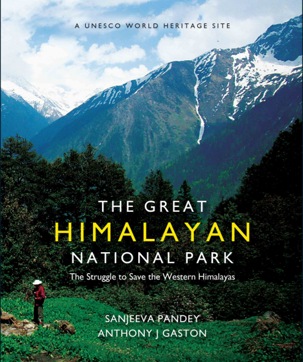Review: The Great Himalayan National Park by Sanjeeva Pandey and Anthony J Gaston
A book on The Great Himalayan National Park that focusses on an especially rich part of the Western Himalayas brings alive lesser known aspects of the magnificent mountains

“The comfortless snow-shires, the frozen rocks: this place was not hostile to my presence, far from it. Just entirely, gradelessly indifferent,” writes nature author Robert Macfarlane in his book, The Wild Places.
Many natural spaces can be intimidating, because they exist in an unapologetically wild state. But this certainly feels more true for the mountains. Mountain ranges, spread out like vast chain-links of meaning, can make you feel alive and set your skin tingling with a not-fully-understood spirituality. Or their vastness and lofty beauty can make you feel like the loneliest, most insignificant person on earth. Writing about mountains Macfarlane notes: “All travellers to wild places will have felt some version of this, a blazing perception of the world’s disinterest. In small measures it exhilarates. But in full form it annihilates.”
Any book on mountains has to convey this duality: a sweep of beauty that can never be fully understood; a feeling of intimacy shrouded in mystery and remoteness.

The Great Himalayan National Park - The Struggle to Save the Western Himalayas focusses on an especially rich part of the Western Himalayas. Early on, the authors stress that they want to bring alive lesser known aspects of the Himalayas. “The general preoccupation with the zone of ice and snow is unfortunate because it diverts attention away from the truly extraordinary assemblages of plants and animals that live on the flanks of the mountains,” the authors write. Pandey, who was an Indian Forest Service officer, and Gaston, who did his PhD on Indian wildlife, cover ecology, culture and trekking trails of the GHNP in Himachal Pradesh. They stress on the details: the intermediate zones between altitudes that are endemic habitat; the time a particular flower will blossom; and how the bearded vulture with a one-metre wing span soars in a “slow, majestic fashion along the contours of the mountainside.” They are clearly in awe of the park. But they present why this awe — a product of the known and the unknown — should lead us to protect the diversity of the Himalayas.
Gaston and his team did wildlife surveys in GHNP, which led to the park being notified by the Government of India in the 1980s. Though decades have passed, you feel the area is still very much its own thing, threatened but wilful. Four rivers, Tirthan, Sainj, JiwaNal and Parvati originate in the park, and Pandey and Gaston describe how goral (a kind of goat-antelope) clamber up the slopes and black bears come looking for fruit. They narrate how changing seasons and snow melt create a diversity of colour. Apricot (khumani in Hindi) trees have pale pink blossoms, elms put out purple leaves, and alder trees flower. As the months roll by, locals can tell the monsoon is coming because of the flowering of the whipcord cobra lily in rhododendron forests. The whipcord cobra lily looks like its name suggests: a cobra with its head up and hood spread out. Another local, unique flower with a literal name is the snowball flower — a blossom like a large, fluffy snowball.

Then there is the native Brahma kamal, a white and purple flower, which looks like it could be made of paper; a flower one wants to see, standing on a cool mountain slope. Local communities consider this to be Lord Brahma’s lotus. The authors tell us there are several Brahma kamals in Parvati Ka Bagicha (garden of goddess Parvati) at Srihand Mahadev, more than 5,000 metres above sea level.
A great deal of data is presented in this 364-page book, which makes it more a text book than a coffee table book. My favourite bits, though, were the unexpected flashes of material in between the straightforward text. For instance, we meet Shastriji, who ran a school in a cave for 13 years in Shakti village in Sainj Valley, simply because no other building was available. In pictures, we find a Gaddi shepherd carrying a new-born lamb, and other men carrying bunches of wild flowers — a kind of masculinity particular to the people of this ecosystem, that is to be cherished. A number of pictures accompany the text and data. This is a labour of love and a lifetime of work, a lifetime during which the park was also notified as a UNESCO World Heritage Site.
Read more: HP’s largest wildlife sanctuary to let dogs out to tackle staff shortage, wildlife crime
Information is the book’s primary aim, and it is full of government report-styled tables, flow charts and sections. I wish more insights accompanied the information. I wanted to know what the authors thought on the issues presented beyond these compilations. I would have liked more words on Shastriji, more field notes and raconteurship. The book could also have contained clearer portions on the political and climate challenges to the Himalayas now; faced as we are with climate change and a general apathy towards conservation. The writing varies between being descriptive and exceedingly formal. An effort to blend both styles would have appealed more to a lay audience.
Be that as it may, the book will be a rich source for researchers, scholars, and visitors, and should be sought out by those who enjoy history and not just the present. There is undeniably an old-fashioned, stoic quality about the book. Perhaps, it sought to mimic the mountains.
Neha Sinha is with the Bombay Natural History Society.



